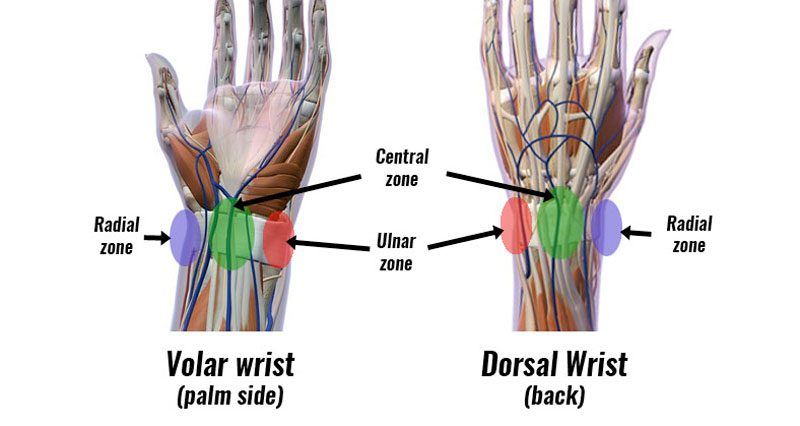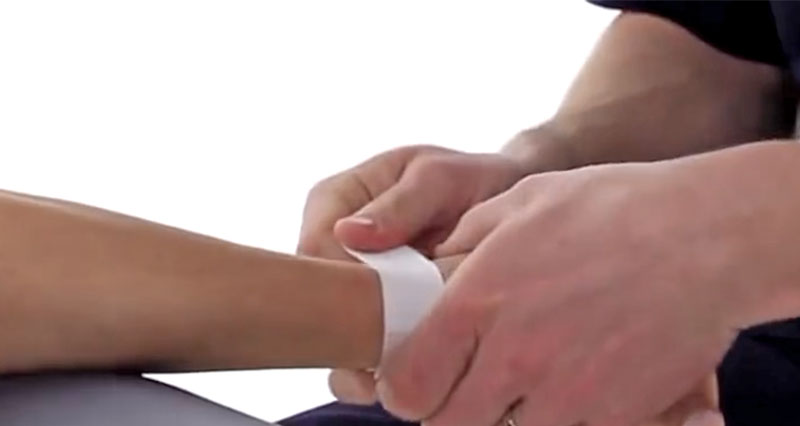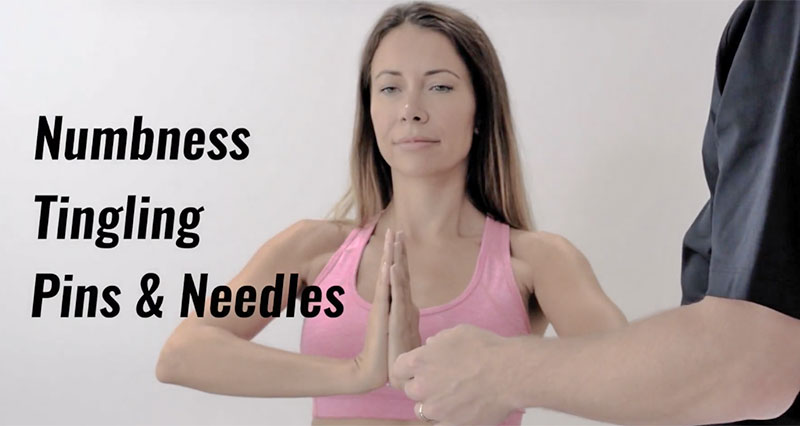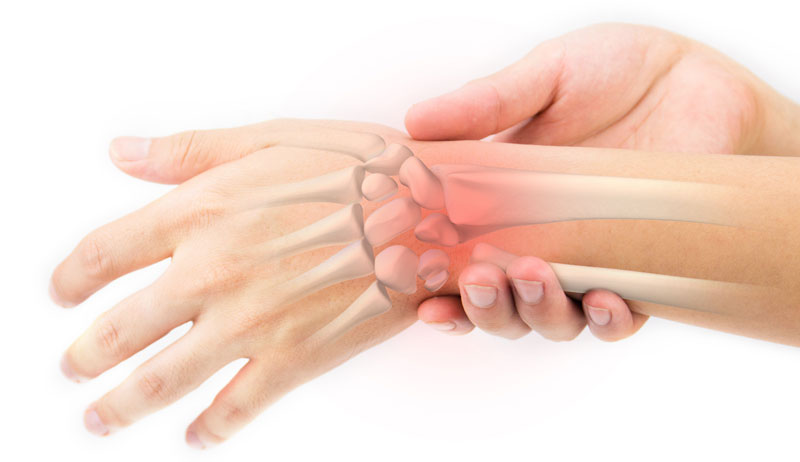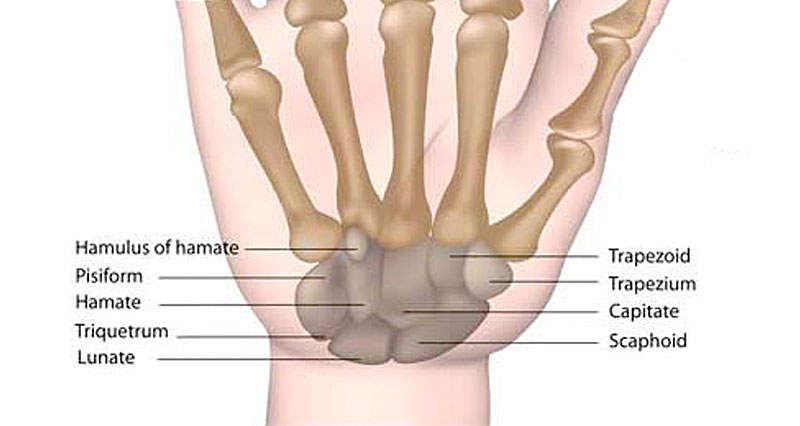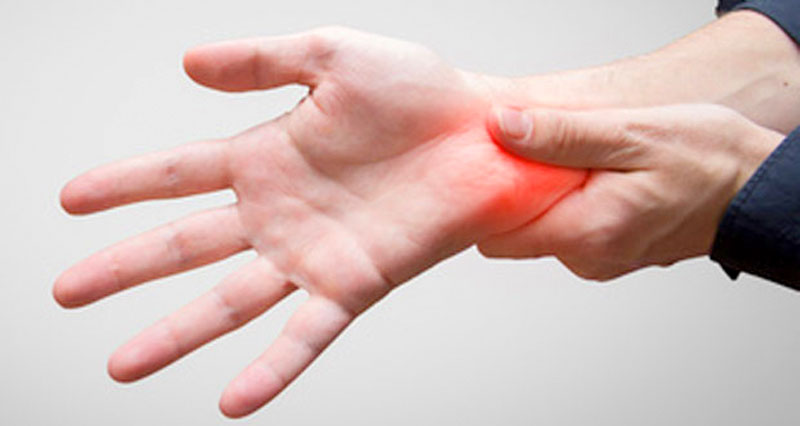Here we explain the common and less common causes of wrist pain by specific location or area. Dorsal wrist pain is located at the back of the wrist. It subdivides into radial (thumb side), central and Ulnar (little finger side) zones. Volar wrist pain is on the inside, or underside, of the wrist comprising radial (thumb side), central and Ulnar (little finger side) zones.
Dorsal wrist pain (back)
Click the area to view more:
Radial wrist pain
The dorsal radial zone is the area of the wrist near the thumb over the palm side.
Most common:
- Extensor carpi radialis tenosynovitis – inflammation of the sheath surrounding the tendon.
- DeQuervain’s tenosynovitis – inflammation of the sheath that surrounds two tendons in the wrist at the base of the thumb.
- Scaphoid fracture – a fracture to the carpal bone in the wrist called the Scaphoid.
- Distal radius fracture (Colles fracture) – a fracture of the end of the radius bone in the forearm.
Less common:
- Intersection syndrome
- Anterior interosseous nerve compression/syndrome
- Radial nerve compression
- Extensor pollucis longus impingement
- Lister’s tubercle
Important not to miss:
- Carpal dislocation – dislocation of any of the small bones which make up the wrist.
- Radial epiphyseal stress reaction – an overuse injury affecting the growth plate of the radius bone. This is more likely to affect young athletes.
Central zone wrist pain
The dorsal central zone is the middle area of the back of the wrist.
Most common:
- Posterior interosseous/radial nerve entrapment
- Ganglion cyst – a ganglion cyst or wrist ganglion is a small lump that appears in the wrist and is often attached to a ligament.
- Scapholunate ligament sprain – wrist sprain affecting the ligament between the scaphoid bone and lunate bones.
Less common:
- Impingement syndromes
Important not to miss:
- Scapholunate dislocation – this is dislocation of the scaphoid bone where it connects to the lunate bone.
- Perilunar dislocation
- Kienbocks disease
Ulnar zone wrist pain
The dorsal ulnar zone is the area of the wrist on the inside near the little finger.
Most common:
- Extensor carpi ulnaris tenosynovitis – inflammation of the tendon sheath.
- TFCC tear – a tear of the triangular fibrocartilage complex found in the wrist.
- Ulnar styloid fracture
- Triqeutral fracture
Less common:
- Distal radioulnar joint instability
- Ulnar fracture
- Luno-triquetral ligament sprain
- Extensor carpi ulnaris subluxation
Volar wrist pain (front)
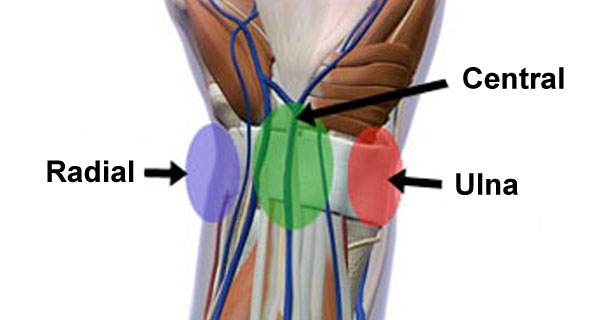
Radial zone
The volar-radial zone is the front/inside of the wrist on the thumb side.
Most common
- Carpo-metacarpal osteoarthritis
Less common
- Flexor carpi radialis tendinopathy
Important not to miss:
- Carpal instability
Central zone
The volar central zone is the inside middle of the wrist.
Most common
Less common
- Pisotriquetral degenerative joint disease
Ulnar zone
The volar ulnar zone is the front/inside of the wrist on the little finger side.
Most common
Less common
- Hook of hamate fracture
- Ulnar nerve compression
- Flexor carpi ulnaris tendinopathy – wrist tendonitis/inflammation of the tendon sheath.
Acute wrist injuries
Sudden onset injuries or acute injuries include wrist fractures, sprains, strains, and contusions.
Fractures
Wrist fractures (broken wrist) is a fracture or break of either the radius and/or ulna forearm bones. Or any of the smaller carpal bones in the wrist. There are a number of different types of wrist fractures, so an accurate diagnosis is essential.
Strains
Wrist strain is often a general term describing pain in the wrist. Strictly speaking, a strain is a tear of a tendon which attaches muscle to bone. Wrist strains can occur suddenly, or develop gradually through overuse.
Sprains
Wrist sprain is an injury to any of the ligaments which connect bone to bone in the wrist. It is a common wrist injury, usually caused by a significant impact like a fall. There are different grades of a sprain, depending on their severity.
TFCC tear
TFCC tear is an injury to the triangular fibrocartilage complex, found in the wrist, between the end of the ulna bone and the carpals. A tear can be caused by a specific incident or develop gradually.
Symptoms include wrist pain with restricted wrist and hand function. Often treated conservatively with a splint, although severe injuries need surgery.
- View all acute wrist injuries
Chronic wrist pain
Gradual onset injuries or chronic injuries occur over a period of time. You are unlikely to trace back to a single incident or cause.
Wrist tendonitis
Wrist tendonitis is inflammation, or more likely degeneration, of any of the flexor or extensor tendons which cross the wrist joint. Repetitive movement and overuse can cause stiffness and pain in the wrist, and there can also be swelling. Sports and repetitive work are common causes of tendonitis.
Carpal tunnel syndrome
Carpal tunnel syndrome is a common cause of wrist pain. A dull ache is felt in the wrist and forearm with pain which may radiate into the hand and fingers. It is often worse at night and a tingling sensation can be felt. We explain the symptoms, causes, and treatment including exercises and surgery.
Distal radial epiphyseal injury
Distal radial epiphyseal injury is distal radial epiphysis injury is an injury to the growth plate at the wrist end of the radius bone in the forearm. It mostly affects young athletes and is most often caused by overuse.
Ganglion cyst
Ganglion cyst or wrist ganglion is a small lump which appears in the wrist, often attached to a ligament. The size of the cyst and the severity of the wrist pain varies from person to person.
Some ganglions are not painful so you can just leave them alone. However, others hinder movement and cause pain, therefore, may require treatment.
Wrist bursitis
Wrist bursitis is inflammation of a bursa is a small sack of fluid found in the wrist. It lubricates where tendons move in joints. There are two in the wrist. If a bursa is subjected to repeated trauma or friction then it can become inflamed and swollen, causing wrist pain. Although the pain can be severe, wrist bursitis can often go away with rest, ice and compression, without the need for any major treatment.
- View all chronic wrist injuries
